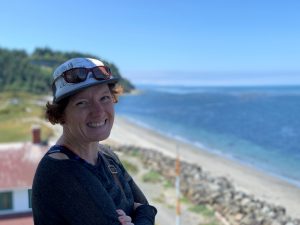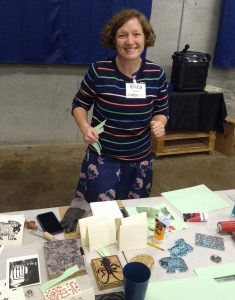Erica Warren — Biologist at BioMaAS

Erica is an environmental scientist and educator. She recently joined BioMaAs Inc. as a biologist, working to reduce environmental impacts during electrical line maintenance. She enjoys diverse projects such as fuel inventories and helping municipalities model wildfire danger. Erica has a broad interest in regional land management; she specializes in riparian and wetland restoration, as well as California red-legged frogs.
Previously, Erica worked in project-based environmental education. She has integrated her art into her curriculum; an example is a floor-sized board game about toxoplasmosis infection in marine mammals.
Erica has a dual Bachelor of Arts degree in Art and Ecology from Evergreen State College in Olympia, Washington and a Master of Science in Environmental Management from the University of San Francisco. She joined WEN’s board in October 2019.
How did you become interested in environmental work?
I came to environmental work by way of outdoor recreation and a desire to work outdoors. As a child growing up in the South Bay, we took many excursions as a family in our national parks. We would pack a dry water bottle full of plaster of Paris along in our bag. When opportunity struck, we would add water and make cast forms from the animal tracks we found.
As a high school student I was lucky to connect with the natural world through hiking, skiing, and climbing with like-minded friends. I grew fond of the physical challenges of the winter environment, the cellular adaptations of trees to winter, and variations in the avian population’s richness and diversity with elevation gains. My recreational enjoyment of the outdoors continues to drive my professional interests and determination to protect what I love.
What environmental issues are of most concern to you?
Water quality and ecosystem services concern me, and natural resource extraction poses a significant threat to water access. Mining, in particular, increases siltation and impairs streams and rivers for salmon. Mining pools can leach, potentially poisoning the waterways for generations.
We are facing significant environmental deregulation, and with it a resurgence of interest in dead mining projects. In Alaska, Pebble Mine is reinvigorated. Pebble Mine sits near Lake Iliamna in southwestern Alaska, between the headwaters of two rivers that drain into Bristol Bay. The area provides prime salmon habitat and fuels a sustainable salmon fishery valued at $1.5 billion. A potential chemical leak would destroy the entire ecosystem downstream. Public protest has halted this proposal in the past. To comment, you can follow this petition link.
Discuss any mentors who have helped or inspired you to reach your aspirations.

Erica sharing some of her original crafts with WEN members at our December 2019 holiday fair.
My environmental work began in 2010, when I was a Watershed Stewards Project-AmeriCorps member with the Greater Farallones National Marine Sanctuary. It was a significant opportunity wherein I gained experience with fisheries, riparian restoration fieldwork, and environmental outreach, and built out new contracts for the education department. My mentors there, Justin Holl and Carol Preston, fostered my teaching experience in schools and encouraged me to start the Sanctuary Explorations program. They established my experience with contract agreements, modeled how to be magnanimous partners, and encouraged me to follow my curiosity.
Inspired by the opportunities that I have been provided through mentorship, I have been mentoring others. I currently work with environmental science students and others who wish to apply their specific skillsets to the environmental field.
What do you think are some challenges and opportunities facing women in the environmental movement today?
Professional opportunities are often posed as challenges. There are many environmental and logistical challenges that pose professional opportunities for women today. These include, but are not limited to:
- Promote sustainability in corporate decision-making and cultural conversations
- Use economic structures to make it profitable to protect our natural resources
- Bring diverse voices to address problems
- Enforce regulations
- Research: If you are looking for more problems that urgently require practical solutions, I suggest two sources:
- Project Drawdown’s Table of Solutions, which is sortable by the amount of carbon that would be globally sequestered per solution
- Work to reverse one of the environmental protection reversals and rollbacks enacted by our current administration
Want to connect with Erica? You can connect with her personally on LinkedIn.
